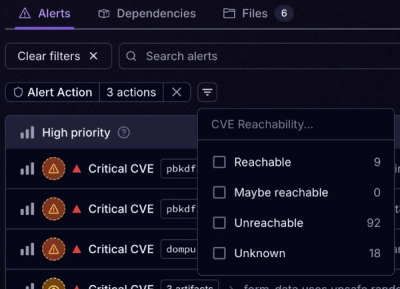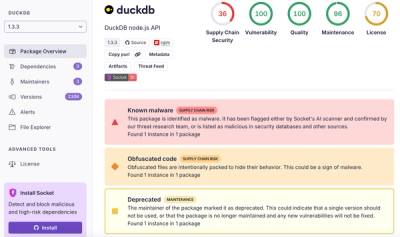
Product
Introducing Tier 1 Reachability: Precision CVE Triage for Enterprise Teams
Socket’s new Tier 1 Reachability filters out up to 80% of irrelevant CVEs, so security teams can focus on the vulnerabilities that matter.
create-webiny-project
Advanced tools
A tool for setting up a new Webiny project.
npx create-webiny-project@local-npm my-test-project --tag local-npm
npx create-webiny-project@local-npm my-test-project
--tag local-npm --no-interactive
--assign-to-yarnrc '{"npmRegistryServer":"http://localhost:4873","unsafeHttpWhitelist":["localhost"]}'
--template-options '{"region":"eu-central-1","vpc":false}'
This usage is more ideal for CI/CD environments, where interactivity is not available.
But do note that this is probably more useful to us, Webiny developers, than for actual Webiny projects. This is simply because in real project's CI/CD pipelines, users would simply start off by cloning the project from their private repository, and not create a new one with the above command.
Testing this, and related packages (like cwp-template-aws) is a bit complicated, because in order to get the best results, it's recommended to test everything with packages published to a real NPM.
But of course, publishing to NPM just to test something is not ideal, and that's why, we use Verdaccio instead, which is, basically, an NPM-like service you can run locally. So, instead of publishing packages to NPM, you publish them to Verdaccio, which is much cleaner, because everything stays on your laptop.
So, you've made some changes, and now you'd like to see the create-webiny-project in action.
The following steps show how to do it.
yarn verdaccio:startnpm config set registry http://localhost:4873yarn release --type=verdaccioOnce the release is done:
npx create-webiny-project@local-npm my-test-project --tag local-npm --assign-to-yarnrc '{"npmRegistryServer":"http://localhost:4873","unsafeHttpWhitelist":["localhost"]}'Start by running the yarn verdaccio:start command, which will, as the script name itself suggests, spin up Verdaccio
locally.
All of the files uploaded to Verdaccio service will be stored in the
.verdacciofolder, located in your project root.
Once you have Verdaccio up and running, you'll also need to change the default NPM registry. Meaning, when you
run npx create-webiny-project ..., you want it to start fetching packages from Verdaccio, not real NPM. Verdaccio runs
on localhost, on port 4873, so, in your terminal, run the following command:
npm config set registry http://localhost:4873
Note that this will only help you with npx, but won't help you when a new project foundation is created, and the
dependencies start to get pulled. This is because we're using yarn2, which actually doesn't respect the values that were
written by the npm config set ... command we just executed.
It's super important that, when you're testing your npx project, you also pass the following argument:
--assign-to-yarnrc '{"npmRegistryServer":"http://localhost:4873","unsafeHttpWhitelist":["localhost"]}'
This will set the necessary values in yarn2 config file, which will be located in your newly created project. But don't worry about it right now, this will be revisited in step 4.
Yarn2 projects don't rely on global configurations and is not installed globally, but on per-project basis. This allows having multiple versions of yarn2, for different projects.
Commit (no need to push it if you don't want to) all of the code changes, and execute the following command:
yarn release --type=verdaccio
Test your changes with the following command:
npx create-webiny-project@local-npm my-test-project --tag local-npm --assign-to-yarnrc '{"npmRegistryServer":"http://localhost:4873","unsafeHttpWhitelist":["localhost"]}'
This should create a project, with all of the packages pulled from Verdaccio.
Once you're done, do the following:
npm config set registry https://registry.npmjs.org/.verdaccio folder| Description | Command |
|---|---|
Remove .verdaccio folder | rm -rf .verdaccio |
| List all v5* tags | git tag -l "v5*" |
| Remove specific tag | git tag -d "v5.0.0-next.5" |
| Set Verdaccio as the NPM registry | npm config set registry http://localhost:4873 |
| Reset NPM registry | npm config set registry https://registry.npmjs.org/ |
| Start Verdaccio | yarn verdaccio:start |
| Release to Verdaccio | yarn release --type=verdaccio |
| Create a new Webiny project | npx create-webiny-project@local-npm my-test-project --tag local-npm --assign-to-yarnrc '{"npmRegistryServer":"http://localhost:4873","unsafeHttpWhitelist":["localhost"]} |
| Revert versioning commit | git reset HEAD~ && git reset --hard HEAD |
This is probably because of one of the Yarn package caching mechanisms.
Yarn has two levels of cache - local and shared.
When you install a package, it gets cached in the local cache folder (located in your project), and in the shared cache folder. This makes it much faster when you're working on a couple of projects on your local machine, and you're pulling the same package in each. If the package doesn't exist in local cache, it will be pulled from shared cache.
On Windows, the shared cache folder should be located in: C:\Users\{USER-NAME}\AppData\Local\Yarn.
On Linux/Mac, the shared cache folder should be located in: /Users/adrian/Library/Caches/Yarn.
In these folders, most probably, you'll also have the \Berry\cache folder. But, there were also cases where this
folder did not exist.
Deleting the mentioned cache folders should help with the issue of still receiving old packages in your testing sessions.
With all of this being said, you can also try the following command:
yarn cache clean --mirror
FAQs
Webiny project bootstrap tool.
The npm package create-webiny-project receives a total of 168 weekly downloads. As such, create-webiny-project popularity was classified as not popular.
We found that create-webiny-project demonstrated a healthy version release cadence and project activity because the last version was released less than a year ago. It has 1 open source maintainer collaborating on the project.
Did you know?

Socket for GitHub automatically highlights issues in each pull request and monitors the health of all your open source dependencies. Discover the contents of your packages and block harmful activity before you install or update your dependencies.

Product
Socket’s new Tier 1 Reachability filters out up to 80% of irrelevant CVEs, so security teams can focus on the vulnerabilities that matter.

Research
/Security News
Ongoing npm supply chain attack spreads to DuckDB: multiple packages compromised with the same wallet-drainer malware.

Security News
The MCP Steering Committee has launched the official MCP Registry in preview, a central hub for discovering and publishing MCP servers.